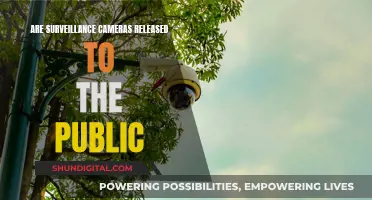
Traffic cameras are video cameras that observe traffic on roads and are typically installed along major roads such as highways and freeways. They are distinct from road safety cameras, which are installed to enforce road rules by taking high-resolution photos upon a trigger. Traffic cameras are used for observation and continuously record lower-resolution videos. They are often mounted on high poles or masts, or on traffic light poles at intersections. Speed cameras, a type of road safety camera, monitor and enforce speed limits and are often placed in less populated areas. They can be fixed or mobile.
| Characteristics | Values |
|---|---|
| Purpose | Detecting motoring offences, including speeding, red light running, toll booth avoidance, unauthorised use of bus lanes, and congestion charge avoidance |
| Installation Location | Beside or over a road, inside an enforcement vehicle, or at toll booths, bus lanes, congestion charge zones, and intersections |
| Functionality | May be linked to an automated ticketing system, or used for number-plate recognition |
| Camera Type | Fixed or mobile, mounted on poles, traffic lights, or signals, or installed inside enforcement vehicles |
| Power Source | Mains power, solar panels, or other alternative power sources |
| Image Type | Still photos or continuous video, in high or low resolution |
What You'll Learn

Traffic cameras vs road safety cameras
Traffic cameras and road safety cameras are both used to monitor traffic and enforce road rules, but they have distinct features and purposes.
Traffic Cameras
Traffic cameras are video cameras used to observe vehicular traffic on roads. They are typically installed along major roads such as highways, freeways, expressways, and arterial roads. These cameras are connected by optical fibres and powered by electricity, solar panels, or alternative energy sources to provide consistent imagery without power outages. A monitoring centre receives live video footage, enabling dispatchers to respond to traffic collisions and incidents promptly. Traffic cameras are essential components of intelligent transportation systems, especially in tunnels, where they facilitate remote activation of safety equipment. On surface roads, they are often mounted on high poles or masts, while in remote areas, they rely on renewable energy sources like solar power.
Road Safety Cameras
Road safety cameras, also known as traffic enforcement cameras, are specifically designed to enforce road rules by capturing still photos of vehicles violating regulations. These cameras are usually placed at specific locations to detect speeding, red-light running, toll booth evasion, and unauthorised use of bus lanes. They may be linked to an automated ticketing system, issuing fines to offenders. Studies have shown that speed cameras, in particular, can lead to a significant reduction in fatal and serious injury crashes. For example, a worldwide review found that speed cameras reduced such crashes by 11% to 44%.
Key Differences
The primary distinction between traffic cameras and road safety cameras lies in their purpose and functionality. Traffic cameras are primarily used for observation and monitoring traffic flow, while road safety cameras are specifically employed to enforce road rules and issue violations. Additionally, traffic cameras provide continuous live video footage, often in full motion, whereas road safety cameras capture still photos with higher image resolution upon being triggered by a violation. The placement of these cameras also differs, with traffic cameras typically installed along major roads and road safety cameras positioned at specific locations to target rule violations.
Understanding Shutter Priority Mode: Creative Control for Photographers
You may want to see also

Traffic cameras and privacy
Traffic cameras are video cameras that observe traffic on roads, typically placed along major roads such as highways and freeways. They are distinct from road safety cameras, which are installed to enforce road rules by taking high-resolution photos. Traffic cameras are used for observation and take lower-resolution videos. Many transportation departments have linked their camera networks to the internet so that travellers can view traffic conditions.
In the UK, there have been concerns about the potential for the government to establish mass surveillance of vehicle movements and, by association, the movements of vehicle owners. A case was taken to the European Court of Human Rights, which found that human rights were not being breached.
In Melbourne, Australia, Melbourne Airport introduced automatic number-plate recognition cameras in their bus forecourt to monitor bus lanes and provide charging points based on vehicle type and dwell time. Entry and exit cameras determine the length of stay and provide alerts for unregistered or concerning vehicles.
Unlocking the Free Camera Mode in Conan Exile
You may want to see also

Traffic camera locations
Traffic cameras are distinct from road safety cameras, which are installed at specific locations to enforce road rules by capturing high-resolution images upon a trigger. Traffic cameras, on the other hand, are used for observation and continuously record lower-resolution videos. They are typically installed along major roads like highways, freeways, expressways, and arterial roads.
- Highways: Traffic cameras are often positioned along highways, which are major roads with high traffic volumes and faster-moving vehicles. These cameras help monitor traffic flow and detect speeding or other violations.
- Freeways and Expressways: Similar to highways, freeways and expressways are designed for high-speed travel, making them ideal locations for traffic cameras to enforce speed limits and detect other traffic offences.
- Arterial Roads: These are major roads that connect different parts of a city or region. Traffic cameras are typically mounted on high poles or masts along arterial roads to capture a wide area and monitor traffic conditions.
- Intersections: Traffic cameras are often installed at intersections, especially those with traffic lights, to detect red-light violations and prevent accidents.
- Remote Areas: In areas beyond the reach of the electrical grid, traffic cameras are usually powered by renewable energy sources like solar power, ensuring uninterrupted surveillance.
- Urban Areas: In cities and urban environments, traffic cameras are commonly powered by mains electricity and are connected to monitoring centres that receive live video feeds.
- Tunnels: Traffic cameras play a crucial role in enhancing the safety of road tunnels by providing remote monitoring and enabling the activation of safety equipment when needed.
The specific locations of traffic cameras vary across different regions and are determined by local authorities. For example, in Western Australia, the police force publishes most fixed and mobile camera locations to encourage drivers to adhere to speed limits and reduce the risk of serious or fatal crashes.
GoPro Cameras: Unveiling the Materials Behind the Adventure
You may want to see also

Traffic camera footage use
Traffic cameras are an essential component of intelligent transportation systems, providing real-time monitoring and aiding in incident management. They are typically installed along major roads and highways, powered by electricity or alternative sources like solar panels. These cameras capture continuous footage of traffic conditions, which can be crucial in determining the cause of accidents and holding accountable those responsible for violations.
- Accident Investigation and Evidence: Traffic camera footage is invaluable for investigating road accidents and determining their causes. It can help identify at-fault drivers, verify accounts of events, and support insurance claims. Obtaining footage may involve locating the relevant camera, identifying its jurisdiction, and contacting the appropriate authority, such as the police or department of transportation.
- Law Enforcement: Traffic enforcement cameras are used to detect and enforce motoring offenses, including speeding, red-light violations, toll booth evasion, and unauthorized use of bus lanes. This footage can be linked to automated ticketing systems, aiding in efficient enforcement.
- Road Safety: Traffic cameras play a vital role in enhancing road safety. For instance, speed cameras have been found to reduce fatal and serious injury crashes by 11% to 44%. They also help monitor and enforce compliance with various road rules, such as stopping at red routes or bus lanes.
- Privacy Concerns: The widespread use of traffic cameras has raised concerns about privacy and the potential for mass surveillance of vehicle movements. While vehicle owners are often required to identify the driver, some argue that this infringes on civil liberties and enables "Big Brother tactics."
- Public Accessibility: Many transportation departments have linked their camera networks to the internet, allowing travelers to access live traffic conditions and plan their routes accordingly. This information is considered public domain in many states and provinces, and it is often shared with news broadcasters during traffic reports.
- Video Tolling: Traffic cameras are also used for video tolling, where license plate images are captured as vehicles pass through open road tolling gantries. This information is then used for billing purposes, ensuring accurate toll collection.
- Obtaining Footage: Obtaining traffic camera footage can be a complex process, and it's important to act quickly. The procedure may vary depending on the jurisdiction, but typically involves identifying the camera's location and jurisdiction, contacting the appropriate agency, and submitting a formal request with relevant details.
Cameras in Ohio: Traffic Control Devices?
You may want to see also

Traffic camera maintenance
Traffic cameras are an essential component of intelligent transportation systems, providing real-time monitoring and aiding in incident response. To ensure their functionality, proper maintenance procedures must be established. Here is a detailed guide on traffic camera maintenance:
Regular Cleaning and Inspection:
- Traffic cameras are exposed to various elements, including dust, dirt, and debris, especially in areas with ongoing construction or high pollution levels. Establish a regular cleaning schedule to ensure the lenses are free from obstructions, maintaining clear and focused imagery.
- During cleaning, inspect the cameras for any physical damage, such as cracks or dislodged parts. Minor issues, such as loose screws or damaged seals, can be addressed promptly to prevent further complications.
Calibration and Testing:
- Calibration is critical for the accuracy of traffic cameras, especially those used for enforcement purposes. Regularly calibrate the cameras to ensure they provide correct speed readings and precise image captures.
- Conduct testing to verify the proper functioning of all camera components, including the lens, sensor, and connectivity. This testing should also evaluate the camera's performance in varying lighting conditions to ensure optimal image quality at all times.
Preventative Maintenance:
- Implement a scheduled maintenance routine to proactively address potential issues. This includes checking for firmware or software updates, ensuring optimal performance, and enhancing security measures.
- Regularly inspect and maintain the camera's power source, whether it is mains power, solar panels, or alternative sources. Ensure that backup power solutions, such as batteries or additional power sources, are also maintained to provide uninterrupted operation during power outages.
Remote Monitoring and Control:
- Many traffic cameras offer remote access capabilities. Utilize this feature to monitor the camera's performance and make adjustments remotely, reducing the need for frequent on-site visits.
- Regularly review the camera's orientation and field of view to ensure it captures the desired area effectively. Make remote adjustments as necessary to optimize the camera's coverage.
Data Management and Storage:
- Traffic cameras generate significant amounts of data, including video footage and still images. Ensure sufficient storage capacity to retain this data for the required duration, adhering to any relevant data retention policies or legal requirements.
- Implement data backup solutions to safeguard against data loss. This can include off-site backups or cloud-based storage systems, ensuring the data's integrity and availability for future reference or analysis.
Maintenance Documentation:
Maintain detailed records of all maintenance activities, including cleaning, repairs, calibration, and testing. This documentation ensures a comprehensive history of the camera's upkeep, allowing for easier troubleshooting and providing valuable insights for future maintenance tasks.
By following these comprehensive maintenance procedures, transportation authorities can ensure the optimal performance and longevity of their traffic cameras, contributing to improved road safety and efficient incident response.
Troubleshooting Galaxy S6 Camera Focus Issues
You may want to see also
Frequently asked questions
A traffic camera is a video camera that observes vehicular traffic on a road. They are typically installed along major roads and highways and are connected by optical fibres. They provide a live feed to a monitoring centre, which can act as a dispatcher in the event of a collision or other incident.
Traffic cameras are for observation only and continuously record lower-resolution video. Road safety cameras, on the other hand, are installed to enforce road rules and take high-resolution still photos when triggered.
A red-light camera is a type of road safety camera that takes photos of vehicles that go through red lights at intersections. They are typically bulky systems with two external flashlights mounted at an intersection.
Speed cameras monitor and enforce speed limits. They are often placed in less populated areas such as back roads or residential areas. They can be fixed (mounted on poles) or mobile (set up by law enforcement).







